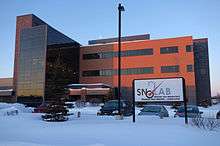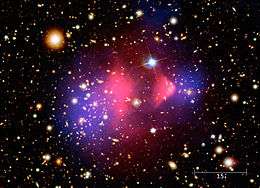SNOLAB
SNOLAB is a Canadian underground physics laboratory at a depth of 2 km in Vale's Creighton nickel mine in Sudbury, Ontario. The original Sudbury Neutrino Observatory (SNO) experiment has ended, but the facilities have been expanded into a permanent underground laboratory.

Although accessed through a mine, the laboratory proper is maintained as a class-2000 cleanroom, with very low levels of dust and background radiation.
SNOLAB is the world's second-deepest underground lab facility; its 6,800 feet (2,070 m) overburden of rock provides 6010 metre water equivalent (MWE) shielding from cosmic rays, providing a low-background environment for experiments requiring high sensitivities and extremely low counting rates.[1]
History
The Sudbury Neutrino Observatory was the world's deepest underground experiment since the Kolar Gold Fields experiments ended with the closing of that mine in 1992.[2] With the deepest underground laboratory in North America at 2100 metre water equivalent depth, and the deepest in the world at 4800 m.w.e., many other groups were interested in conducting experiments in the 6000 m.w.e. location.
In 2002 funding was approved by the Canada Foundation for Innovation to expand the SNO facilities into a general-purpose laboratory,[3] and more funding was received in 2007[4] and 2008.[5]
Construction of the major laboratory space was completed in 2009,[6] with the entire lab entering operation as a 'clean' space in March 2011.[7]
SNOLAB was briefly the world's deepest underground laboratory, until it was surpassed by the 2.4 km-deep China Jinping Underground Laboratory at the end of 2010. CJPL achieves a muon flux of less than 0.2 μ/m²/day,[8] slightly less than SNOLAB's 0.27 μ/m²/day.[1] (For comparison, the rate on the surface, at sea level, is about 15 million μ/m²/day.)
The planned DUSEL laboratory in the United States, which would have been deeper, was greatly scaled back after the National Science Foundation refused major funding in 2010.[9]
Experiments
As of September 2015 SNOLAB hosts five operating physics experiments:[10][11]:2[12][13]
- The HALO (Helium and Lead Observatory) supernova neutrino detector,
- DAMIC (Dark Matter in CCDs) detector,[14][15]
- The PICO 2L dark matter search prototype[11]:41[16] (PICO is a merger of the former PICASSO and COUPP collaborations),[17][18]
- The second-generation PICO-60 dark matter search,[19] formerly named COUPP-60[20] and
- The second-generation DEAP-3600 dark matter detector,[21] using 3600 kg of liquid argon,[11]:14,21 has completed construction and is commissioning,[22][23] with first physics results expected in 2016.
Four more experiments are currently under construction:[10][12][13]
- The SNO+ neutrino detector (using the original SNO experiment chamber),
- MiniCLEAN (Cryogenic Low-Energy Astrophysics with Noble gases) dark matter detector,[11]:24–32
- SuperCDMS (Cryogenic Dark Matter Search) dark matter detector,[24][25] and
- The DAMIC100 detector.[15]:31
Five experiments have completed and are no longer operating:
- The original heavy water based Sudbury Neutrino Observatory experiment,
- The POLARIS underground project at SNOLAB (PUPS), observing seismic signals at depth in very hard rock,
- The first-generation COUPP 4-kg bubble chamber dark matter search,[26][27][28] is no longer in operation.[29]:25[30]
- The DEAP-1 dark matter search,[29]:25 and
- The PICASSO dark matter search.[31]:3
Additional planned experiments have requested laboratory space such as the next-generation nEXO,[32][33]:16[34]:17 COBRA Experiment searches for neutrinoless double beta decay,[29]:27 and the New Experiments With Spheres (NEWS) electrostatic dark matter detector.[35] There are also plans for a larger PICO-250L detector.[11]:44[17]
The total size of the SNOLAB underground facilities, including utility spaces and personnel spaces, is:[36][37]:26
| Excavated | Clean room | Laboratory | |
|---|---|---|---|
| Floor space | 7,215 m² 77,636 ft² | 4,942 m² 53,180 ft² | 3,055 m² 32,877 ft² |
| Volume | 46,648 m³ 1,647,134 ft³ | 37,241 m³ 1,314,973 ft³ | 29,555 m³ 1,043,579 ft³ |
References
- 1 2 SNOLAB User's Handbook Rev. 2 (PDF), 2006-06-26, p. 13, retrieved 2013-02-01
- ↑ Mondal, Naba K. (January 2004). "Status of India-based Neutrino Observatory (INO)" (PDF). Proceedings of the Indian National Science Academy. 70 (1): 71–77. Retrieved 2007-08-28.
- ↑ "Canada selects 9 projects to lead in international research" (Press release). Canada Foundation for Innovation. 2002-06-20. Retrieved 2007-09-21.
- ↑ "Province Supports Expansion of World's Deepest Lab Administered by Carleton University" (Press release). Carleton University. 2007-08-21. Retrieved 2007-09-21.
- ↑ "New Funding will Support Underground Lab Operations as SNOLAB nears Completion" (PDF) (Press release). SNOLAB. 2008-01-18. Retrieved 2008-02-26.
- ↑ Duncan, Fraser (2009-08-27). "SNOLAB Facility Status" (PDF).
- ↑ http://www.snolab.ca/public/updates/index.html
- ↑ WU Yu-Cheng; HAO Xi-Qing; YUE Qian; LI Yuan-Jing; CHENG Jian-Ping; KANG Ke-Jun; CHEN Yun-Hua; LI Jin; LI Jian-Min; LI Yu-Lan; LIU Shu-Kui; MA Hao; REN Jin-Bao; SHEN Man-Bin; WANG Ji-Min; WU Shi-Yong; XUE Tao; YI Nan; ZENG Xiong-Hui; ZENG Zhi; ZHU Zhong-Hua (August 2013), "Measurement of Cosmic Ray Flux in China JinPing underground Laboratory", Chinese Physics C, 37 (8), arXiv:1305.0899
 , Bibcode:2013ChPhC..37h6001W, doi:10.1088/1674-1137/37/8/086001
, Bibcode:2013ChPhC..37h6001W, doi:10.1088/1674-1137/37/8/086001 - ↑ Pitlick, Wendy (2011-07-15), "DUSEL no more", Black Hills Pioneer, retrieved 2012-11-26,
Lesko said the scaled back plans boil down to just one underground research campus. Originally, lab officials planned to build a major surface campus, a science campus 4,850 feet underground that included two lab modules, and a smaller lab module campus 7,400 feet underground. The Sanford Underground Research Facility, Lesko said, focuses on building just one campus at the 4,850-foot level that will host experiments in dark matter, double beta decay, and long baseline neutrino research.
- 1 2 SNOLAB: Current experiments
- 1 2 3 4 5 Noble, Tony (2014-01-31). Dark Matter Physics at SNOLAB and Future Prospects (PDF). Fourth International Workshop for the Design of the ANDES Underground Laboratory.
- 1 2 Duncan, Fraser (2015-08-24). Overview of the SNOLAB Facility and Current Programme Evolution (PDF). SNOLAB Future Planning Workshop 2015. Retrieved 2015-12-03.
- 1 2 Jillings, Chris (9 September 2015). The SNOLAB science program (PDF). XIV International Conference on Topics in Astroparticle and Underground Physics (TAUP2015). Torino. Retrieved 2015-11-30.
- ↑ DAMIC now running at SNOLAB, 2012-12-10, retrieved 2013-05-13
- 1 2 Cancelo, Gustavo (2014-01-31). The DAMIC experiment (PDF). Fourth International Workshop for the Design of the ANDES Underground Laboratory.
- ↑ "PICO-2L now running at SNOLAB!". 2013-11-04.
- 1 2 Crisler, Michael B. (21 August 2013). PICO 250-liter Bubble Chamber Dark Matter Experiment (PDF). SNOLAB Future Projects Planning Workshop 2013. p. 3. Retrieved 2015-12-03.
PICASSO + COUPP = PICO
- ↑ Neilson, Russell (2013-12-16). COUPP/PICO Status Report (PDF). Fermilab All Experimenters Meeting. p. 7. Retrieved 2015-12-03.
COUPP and PICASSO have merged to form the PICO collaboration to search for dark matter with superheated liquid detectors.
- ↑ "PICO experiment: PICO 60". Retrieved 2015-08-17.
- ↑ COUPP-60 Up and Running at SNOLAB. 2013-05-03. Retrieved 2013-05-13.
- ↑ Field, Louisa (23 April 2015). "Biggest dark matter detector lies in wait for antisocial WIMPs". New Scientist (3108).
At the end of April, it will join other underground detectors worldwide in the race to find dark matter.
- ↑ Pollmann, Tina (18 June 2015). Construction of the DEAP-3600 Dark Matter detector and first commissioning results. MLL Colloquia. Ludwig Maximilian University of Munich. Retrieved 2015-12-03.
- ↑ Walding, Joseph (2013-04-10). "The DEAP-3600 Dark Matter Experiment". IOP 2013: High Energy and Astro Particle Physics. Institute of Physics. p. 3. Retrieved 2013-05-19.
- ↑ "Second generation dark matter experiment coming to SNOLAB" (Press release). SNOLAB. 2014-07-18. Retrieved 2014-09-18.
- ↑ Saab, Tarek (2012-08-01). "The SuperCDMS Dark Matter Search" (PDF). SLAC Summer Institute 2012. SLAC National Accelerator Laboratory. Retrieved 2012-11-28.
- ↑ http://www-coupp.fnal.gov
- ↑ Science at SNOLAB
- ↑ Behnke, E.; Behnke, J.; Brice, S.J.; Broemmelsiek, D.; Collar, J.I.; Conner, A.; Cooper, P.S.; Crisler, M.; Dahl, C.E.; Fustin, D.; Grace, E.; Hall, J.; Hu, M.; Levine, I.; Lippincott, W. H.; Moan, T.; Nania, T.; Ramberg, E.; Robinson, A.E.; Sonnenschein, A.; Szydagis, M.; Vázquez-Jáuregui, E. (September 2012). "First dark matter search results from a 4-kg CF3I bubble chamber operated in a deep underground site". Physical Review D. 86 (5): 052001–052009. arXiv:1204.3094
 . Bibcode:2012PhRvD..86e2001B. doi:10.1103/PhysRevD.86.052001. FERMILAB-PUB-12-098-AD-AE-CD-E-PPD.
. Bibcode:2012PhRvD..86e2001B. doi:10.1103/PhysRevD.86.052001. FERMILAB-PUB-12-098-AD-AE-CD-E-PPD. - 1 2 3 Smith, Nigel J.T. (2013-09-08). "Infrastructure Development for underground labs—SNOLAB experience" (PDF). 13th International Conference on Topics in Astroparticle and Underground Physics. Asilomar, California.
- ↑ "The old COUPP detector using bubble chamber technology to search for dark matter. It is not running right now because they have a bigger detector to assemble and play with!" (2013-01-18)
- ↑ Smith, Nigel (17 June 2015). Advanced Instrumentation Techniques in SNOLAB (PDF). 2015 Canadian Association of Physicists Congress.
- ↑ Sinclair, David (12 September 2013). The SNOLAB Science Programme. 13th International Conference on Topics in Astroparticle and Underground Physics. Asilomar, California. Retrieved 2014-11-21.
- ↑ Pocar, Andrea (8 September 2014). Searching for neutrino-less double beta decay with EXO-200 and nEXO (PDF). Neutrino Oscillation Workshop. Otranto. Retrieved 2015-01-10.
- ↑ Yang, Liang (8 July 2016). Status and Prospects for the EXO-200 and nEXO Experiments (PDF). XXVII International Conference on Neutrino Physics and Astrophysics. London. Video available at Neutrino Conference 2016 - Friday (part 1) on YouTube.
- ↑ "NEWS: New Experiments With Spheres". Retrieved 2015-08-16.
- ↑ Noble, T. (2009-02-18). "SNOLAB: AstroParticle-Physics Research in Canada" (PDF). p. 4.
- ↑ Vázquez-Jáuregui, Eric (2014-01-30). Facility and experiment developments at SNOLAB (PDF). Fourth International Workshop for the Design of the ANDES Underground Laboratory.
External links
- SNOLAB website
- SNOLAB french presentations
- "Experiment Cave". WIRED Science. Episode 104. 2007-10-24. PBS.
- Jepsen, Kathryn (2012-11-05). "Voyage to SNOLAB". Symmetry. ISSN 1931-8367. Retrieved 2012-11-26.
- Semeniuk, Ivan (22 March 2014). "Going deep underground in Canada in search of dark matter". The Globe and Mail. Retrieved 22 March 2014.
- Larmour, Adelle (September 1, 2008). "Redpath completes $65 million SNOLAB expansion". Sudbury Mining Solutions Journal. Retrieved 2015-12-03.
Coordinates: 46°28.3′N 81°11.2′W / 46.4717°N 81.1867°W
